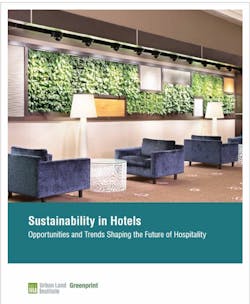Sustainable Hospitality: Global Lodging Grows Greener
Remember when the big hotel chains began leaving cards and hang-tags asking guests to reuse their towels instead of getting new ones each day, thereby conserving water and energy? Did anyone notice that no matter how many times you dutifully hung up your towels to reuse, you still received new ones every day?
Today, the hospitality industry seems much more engaged in developing sustainability programs and seeing them through. And they must if we want to make a significant impact in conserving natural resources. A report from Urban Land Institute Greenprint Center for Building Performance — Sustainability in Hotels: Opportunities and Trends Shaping the Future of Hospitality — notes that hotels are among the highest energy and water users per square foot of commercial buildings.
Figures from the U.S. Department of Energy’s Better Buildings initiative peg the hospitality sector at spending more than $7 billion on energy each year, an average of $2,196 per guest room and 6 percent of total operating costs. HVAC and lighting take up the bulk of those costs — around 45 percent of energy use (32 percent HVAC and 13 percent lighting).
The ULI report also notes that water use in hotels accounts for about 24 percent of total utility expenses and 15 percent of total water use in commercial and institutional real estate in the United States. Bathroom fixtures, laundry, landscaping and kitchens are the biggest hotel water hogs.
“Like other asset classes, hotels interested in improving their efficiency can start with the ‘low-hanging fruit’ measures that reduce operating costs,” the report says. “Opportunities to improve energy, water and waste efficiency are widely available for hotels of all types, through operational changes such as utility benchmarking and temperature setpoint adjustments, as well as technical updates like high-efficiency water fixtures or LED lighting installations.”
That includes offering guests the choice to forgo daily towel and bed linen changes in exchange for brand points — a best practice producing results.
Hotel properties also can undergo renovations to upgrade heating and cooling equipment to take advantage of more energy-efficient equipment on the market.
“Investments in high-efficiency energy management systems, HVAC retrofits, or on-site renewable energy require longer project planning and more overall effort,” the report notes. “Achieving projects of this magnitude requires strong collaboration between owners and operators but can pay long-term dividends for hotels in utility savings and guest comfort.”
But water and energy savings aren’t the only sustainable goals in the hotel industry. The ULI report lists guest health and wellness, protecting the surrounding environment and biodiversity, and helping to mitigate the social impacts of forced labor and human trafficking as other significant objectives to more eco-friendly and social conscious roles.
However, the report admits that as with all commercial building types, the biggest driver of the hotel industry’s sustainability initiatives is boosting net operating income. It explains that all the energy and water savings from any sustainability projects go directly to the hotel property’s bottom line; there are no tenants to share those funds with, such as in an office building.
And as many hotel chains “recognize the strong financial return of sustainability programming,” they have set internal sustainability goals, the report explains. Here is a look at how the four most prominent U.S. hotel groups are tackling these issues.
Marriott International
The Marriott group’s 30 brands use the four-point Serve360 program (serve360.marriott.com), which is guided by the chain’s 2025 Sustainability and Social Impact Goals, as well as the UN Sustainable Development Goals.
Marriott’s targets to reduce its environmental footprint include:
- Water. Reduce water intensity by 15 percent;
- Carbon. Reduce carbon intensity by 30 percent;
- Waste. Reduce waste to landfill by 45 percent, and reduce food waste by 50 percent;
- Renewable energy. Achieve a minimum of 30 percent renewable electricity use.
In addition, by 2025, Marriott wants 100 percent of its properties to obtain certification with a recognized sustainability standard, with 650 pursuing LEED certification. (As of 2018, 225 hotels were LEED-certified.) By 2020, building design and renovation standards will incorporate LEED certification or the equivalent.
Hilton Hotels & Resorts
The 14 Hilton hotel brands are committed to cutting their environmental footprint in half by 2030 (cr.hilton.com/environment).
1. Energy and carbon. The group is committed to reducing Scope 1 (direct emissions from owned or controlled sources) and Scope 2 (indirect emissions from the generation of purchased energy) carbon intensity by 61 percent. To that end, last year, it installed a 1.5 MW photovoltaic solar array at its Grand Wailea/Waldorf Astoria Resort on the island of Maui.
2. Water. The group intends to cut water use by 50 percent. All Hilton properties are required to use LightStay — a proprietary corporate responsibility performance measurement platform — to set water reduction targets and implement a continuous improvement project in line with its 2030 goals. LightStay was developed to measure energy use, water use, waste output and carbon output at every Hilton Worldwide hotel around the globe.
3. Waste. The hotel chain commits to reducing landfill waste by 50 percent, including food waste. More than 3 million pounds of organic waste was diverted from landfills via composting and food digesters.
Wyndham Hotels & Resorts
The 20 brands in the Wyndham portfolio are focused on strategic goals in four areas by the end of 2021 (corporate.wyndhamhotels.com/social-responsibility/).
Wyndham has adopted the Wyndham Green Toolbox, a proprietary online environmental management system, developed to track, measure and report energy, emissions, water and waste diversion performance globally.
Also, in 2019, it launched the Wyndham Green Certification, a progressive five-level program that builds from the initial core level to expert. Each level is comprised of five to seven actions that address energy, water and operational efficiencies as well as other industry best practices. The hotel chain focuses on four areas to reduce its environmental footprint:
- Climate change. Reduce carbon dioxide emissions not only through Scope 1 & 2, but also Scope 3 — business travel emissions, which includes air travel, car service and rentals;
- Energy efficiency and renewable energy. This includes more efficient lighting and HVAC controls. In 2018, nearly 3,500 properties saved 650,000 therms of natural gas;
- Water conservation. Water-efficient fixtures showerheads in guest rooms as well as low-flow toilets in common areas — plus towel and bed linen reuse — allowed those same properties to conserve more than 84.7 million gallons of water;
- Waste diversion. In 2108, nearly 400,000 pounds of waste was diverted from landfills.
InterContinental Hotels Group
Environmental sustainability for IHG’s 14-brand portfolio focuses on three areas:
1. Carbon and energy. As part of its 2018-2020 targets, instead of purchasing carbon offsets, the company is committed to further reducing the carbon per occupied room by 6 to 7 percent. In its 2018 Responsible Business Report, the company reported a 2.2 percent reduction in the carbon footprint per occupied room.
2. Water. IHG has completed a comprehensive water risk assessment. This allows the company to identify water quantity and quality risks, and put in place tailored water stewardship action plans to apply best practice techniques for each property, particularly those in water-stressed areas. As of 2018, water use per occupied room decreased 3.1 percent.
3. Waste. The company is beginning to map out the most significant areas of waste within its operations, identifying ways to reduce, re-use and recycle to divert as much waste from landfill as possible.
All IHG hotels use the IHG Green Engage system (www.ihg.com/content/us/en/about/green-engage), an online environmental sustainability system measuring and managig their impact on the environment. More than 200 Green Solutions are available to them to help reduce energy and water consumption and waste disposal.
The system has four levels of certification that properties can achieve; those achieving Level 3 certification or above can reduce energy use by up to 25 percent.
- Level 1 is a requirement for all IHG hotels. Properties must complete 10 best practice solutions to provide immediate energy and costs savings. This includes tracking consumption data, setting up a property green team and installing energy-efficient lighting in guest rooms;
- Level 2 hotels have gone beyond the basics. They’ve implemented sustainable purchasing and ingrained sustainability into their operations;
- At Level 3, hotels have mastered the foundations of sustainability. Now the focus is on large projects, such as installing energy-efficient appliances and sustainable site management;
- When properties reach Level 4, they are at the top in environmental sustainability and demonstrate innovative approaches to be used across the brands.
Another area the company focuses on is creating a positive community impact through its IHG Academy, which offers training and mentorship to anyone wanting to start a hospitality career.
With the improvements in energy efficiency and water conservation, reductions in carbon emissions and diverting food waste from landfills, hotel operators must weigh the benefits against guest satisfaction. If low water flow, complicated climate control systems and complex recycling programs mar guests’ experiences, they may not return to that property — or that brand.
“However, many in the hotel industry see sustainability and community initiatives as a strong opportunity to enhance the guest experience,” the ULI report concludes. “Careful consideration of fixtures is key to ensuring balance between guest expectations and sustainability.”
###############
About the Author

Kelly L. Faloon
Contributing Writer/Editor
Faloon spent 3 1/2 years at Supply House Times before joining the Plumbing & Mechanical staff in 2001. Previously, she spent nearly 10 years at CCH/Wolters Kluwer, a publishing firm specializing in business and tax law, where she wore many hats — proofreader, writer/editor for a daily tax publication, and Internal Revenue Code editor.
A native of Michigan’s northern Lower Peninsula, Faloon is a journalism graduate of Michigan State University. You can reach her at [email protected].



